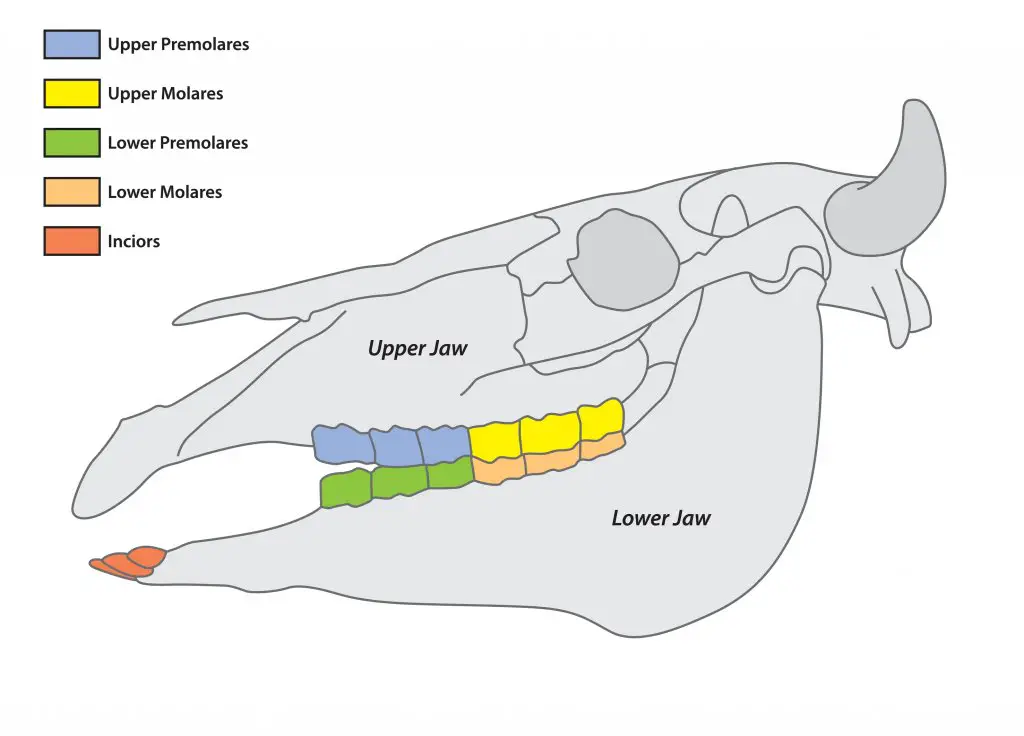Cows don’t have top teeth in the front because they don’t need to chew their food immediately. The upper incisors are replaced with a thick and unique dental pad with a leathery finish. The front teeth of a cow are known as the incisors and are only on the bottom jaw.
All cows do have top teeth which are only found near the rear part of the mouth. The teeth are known as premolars and molars and are positioned on the lower and upper parts of the cow’s jaws.
Why Don’t Cows Have Top Front Teeth?
Cows are ruminants and they have multiple stomachs (rumen, reticulum, omasum, and abomasum). They don’t bite their food often but chew it a little and swallow it quickly to be chewed later. For this reason, there is no need for upper incisors.
A cow is classified under ruminants together with goats, sheep, and giraffes. Ruminants are herbivores who have a four-chambered complex stomach used to digest plant material.

They have a thick dental pad on the upper front which, together with the lower incisors, aids in cutting foliage to be chewed.
The tongue plays a particular role in grabbing and pulling foliage from the ground.
The cut foliage/grass is placed in between the lower incisors and the dental pad by the tongue to be rubbed and shredded into small particles.
How Do Cows Eat?
Cows bite foliage with their lips and rough sandpaper-like tongue to grab and pull it into their mouth.
The grabbed foliage is torn off the ground by an upper thick dental pad aided with the lower incisors. The two (dental pad and lower incisors) press and cut the foliage where it is mixed with saliva that contains enzymes, and shredded into small particles to assist in digestion.
After chewing a little, the cow swallows the food. This action of swallowing is performed by the cow’s esophagus whose muscles have a bidirectional function, meaning they move feed from the mouth to the stomach and from the stomach to the mouth.
The swallowed food travels straight to the rumen, which is the first of the cow’s four stomachs. The other 3 stomachs are the reticulum, omasum, and abomasum.
The rumination (chewing the cud) process starts when the cow finds a nice quiet place, lies down, and regurgitates the previously consumed feed for further chewing and swallowing. The action stimulates saliva secretion and goes on repeatedly for about 8 hours.
Rumination helps in breaking the feed particles into smaller pieces. The secreted saliva helps in reducing the acidity levels in the rumen thus ensuring a stable environment for digestion to continue.
Types Of Cow Teeth
A cow has 3 types of teeth namely incisors, premolars, and molars. A mature cow has 32 permanent teeth, while calves are born with temporary baby teeth (deciduous or milk teeth) which are replaced by permanent teeth by age three.

The incisors are 6 in number, found on the lower jaw, and sharp for cutting and ripping foliage off the ground. Incisor teeth can also be used to estimate a calf, heifer, or cow’s age.
There are 2 canines adjacent to the incisors. Canine teeth are not pointed but the same as the incisors, therefore, they perform the same function.
The premolars are 12 in number, 6 behind the dental pad on the upper jaw and another 6 behind the canines on the lower jaw. They are flat so they’re useful for grinding and crushing food.
The molars are 12 in number, 3 on each side of the lower jaw and another 3 on each side of the upper jaw. They are flat, designed for shredding grass or foliage into small pieces to ease digestion.
The dental pad is on the front part of the upper jaw and works in conjunction with the tongue to grab and pull foliage into the mouth.
